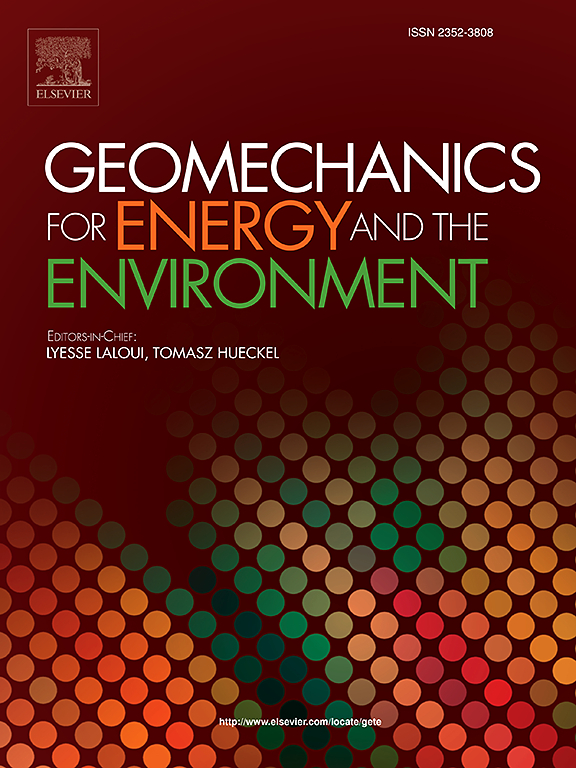Development and validation of TOUGH-3DEC: A three-dimensional discontinuum-based numerical simulator for coupled thermo-hydro-mechanical analysis
IF 3.7
2区 工程技术
Q3 ENERGY & FUELS
引用次数: 0
Abstract
The discontinuum-based numerical methods can simulate the coupled thermo-hydro-mechanical (THM) processes in porous media with multiple discontinuities, so it is appropriate to model the mechanical behavior of a fractured host rock under the coupled processes such as a geological repository for high-level radioactive waste. TOUGH-3DEC, a three-dimensional discontinuum-based simulator for the coupled THM analysis, was developed by linking the integral finite difference method TOUGH2 and the distinct element method 3DEC to describe the coupled THM processes in porous media and discontinuous media. TOUGH2 handles the coupled TH analysis through the internal simulation module, while 3DEC performs mechanical analysis based on the constitutive models of porous media and discontinuity, coupling the thermal and hydraulic responses from TOUGH2. The thermal and hydraulic couplings are key processes and should be carefully verified by sufficient cases, so this study performed TM and HM verifications by modelling analytic solutions including the uniaxial consolidation, fracture static opening, and the heating of a hollow cylinder. As comparative validations, two models describing laboratory-scale experiments regarding the HM and TM processes of fractured rock were simulated and compared to the experimental results. The developed TOUGH-3DEC simulator showed sufficient accuracy in reflecting the coupled THM processes of the small-scale discontinuous rock, but still needs to be verified by more complicated and large-scale coupled process problems to be applicable to the demonstration of the field-scale model requiring the coupled THM processes of various geological media, such as a multi-barrier system of a geological repository.
基于非连续介质的三维热-水-力耦合数值模拟系统tough1 - 3dec的开发与验证
基于不连续面的数值方法可以模拟具有多个不连续面的多孔介质中的热-水-力学耦合过程,因此适合模拟高放废物地质储存库等耦合过程下裂隙围岩的力学行为。将积分有限差分法TOUGH2与离散元法3DEC相结合,开发了基于非连续介质耦合THM分析的三维仿真器tough1 -3DEC,用于描述多孔介质和非连续介质中耦合THM过程。TOUGH2通过内部仿真模块进行耦合TH分析,3DEC基于多孔介质和不连续介质的本构模型进行力学分析,耦合TOUGH2的热响应和水力响应。热耦合和液压耦合是关键过程,需要通过足够的实例进行仔细验证,因此本研究通过建模分析解进行了TM和HM验证,包括单轴固结、断裂静开和空心圆筒加热。作为对比验证,模拟了两个描述破裂岩石HM和TM过程的实验室规模实验模型,并与实验结果进行了比较。所开发的tough3dec仿真器在反映小尺度不连续岩体的耦合THM过程方面具有足够的精度,但仍需要通过更复杂、更大规模的耦合过程问题进行验证,才能适用于需要多种地质介质耦合THM过程的现场尺度模型的演示,例如地质库的多屏障系统。
本文章由计算机程序翻译,如有差异,请以英文原文为准。
求助全文
约1分钟内获得全文
求助全文
来源期刊

Geomechanics for Energy and the Environment
Earth and Planetary Sciences-Geotechnical Engineering and Engineering Geology
CiteScore
5.90
自引率
11.80%
发文量
87
期刊介绍:
The aim of the Journal is to publish research results of the highest quality and of lasting importance on the subject of geomechanics, with the focus on applications to geological energy production and storage, and the interaction of soils and rocks with the natural and engineered environment. Special attention is given to concepts and developments of new energy geotechnologies that comprise intrinsic mechanisms protecting the environment against a potential engineering induced damage, hence warranting sustainable usage of energy resources.
The scope of the journal is broad, including fundamental concepts in geomechanics and mechanics of porous media, the experiments and analysis of novel phenomena and applications. Of special interest are issues resulting from coupling of particular physics, chemistry and biology of external forcings, as well as of pore fluid/gas and minerals to the solid mechanics of the medium skeleton and pore fluid mechanics. The multi-scale and inter-scale interactions between the phenomena and the behavior representations are also of particular interest. Contributions to general theoretical approach to these issues, but of potential reference to geomechanics in its context of energy and the environment are also most welcome.
 求助内容:
求助内容: 应助结果提醒方式:
应助结果提醒方式:


